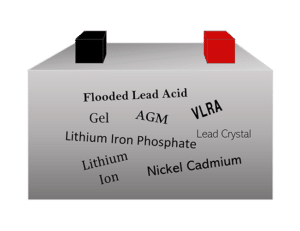 Deep cycle batteries designed to provide consistent power for long durations should be used in off-grid solar applications. as opposed to starter batteries like car batteries that are designed for short bursts of energy output. The best battery chemistry for your off-grid solar applications depends on a number of factors listed below:
Deep cycle batteries designed to provide consistent power for long durations should be used in off-grid solar applications. as opposed to starter batteries like car batteries that are designed for short bursts of energy output. The best battery chemistry for your off-grid solar applications depends on a number of factors listed below:
- Safety
- Maintenance
- Initial costs and total lifetime costs
- Temperatures that the batteries are exposed to
- Weight considerations
- Depth of Discharge that will be incurred
- Charge controller features and charge setting capabilities
- Experience with the battery chemistry type
In terms of safety, AGM or Gel Sealed Lead Acid Batteries are a good choice. They don’t spill acid and they rarely emit gas so they are a good option to use inside living spaces. Lithium iron phosphate batteries are the safest lithium batteries to deploy in living spaces, although they are not generally considered to be as safe as AGM or Gel lead-acid batteries.
AGM and Gel batteries don’t require maintenance like flooded lead-acid batteries. This can be a huge consideration if personnel are typically present at the site and the site is difficult to access. Lithium iron phosphate batteries also require less maintenance than flooded batteries so more of these battery types are being deployed in remote areas for solar-powered environmental monitoring systems, and other other long term, off-grid applications that are not regularly staffed with maintenance personnel.
The lowest up-front battery costs are associated with flooded lead-acid batteries, then sealed batteries, and finally lithium iron phosphate batteries. Properly maintained flooded batteries will also last longer than sealed batteries. While the initial cost of lithium iron phosphate batteries is much higher, they can be an economically viable solution in the long run over many years, if your application experiences frequent high depths of discharge on a regular basis.
Cold temperatures can cause damage when charging batteries, especially lithium batteries, so lead-acid batteries are advantageous to use in these conditions unless insulated enclosures can be deployed to ensure batteries are kept at acceptable temperatures. Some charge controllers feature temperature foldback provisions that also help mitigate problems with charging batteries in cold climates.
Lithium iron phosphate batteries are much lighter and smaller than lead-acid batteries so they are easier to transport and install. They have become very popular in RV-caravan and boating applications.
Lead-acid batteries have been used most often in off-grid applications, and since people have a lot of experience with them some people will continue to use them without considering other options. However, lithium batteries continue to gain popularity, and many brands are listed on our Energy Storage Partner program web page where you can access important custom charge setting information to optimize battery health and safety. Other battery chemistries such as nickel-cadmium and lead crystal have been deployed in some off-grid applications, and select Morningstar controllers can match their recommended charging setpoints.
